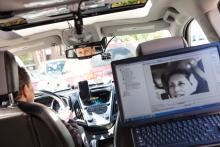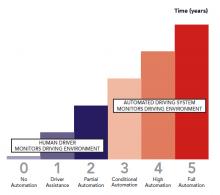In-vehicle systems are making huge advances in vehicle safety with the introduction of ABS, collision avoidance, adaptive cruise control, lane departure alert and blind spot warning… the list goes on. But at the same time accidents are still happening and arguably getting bigger. A look at a list of multi-vehicle (30 - 300) accidents across Europe, North and South America and parts of the Middle East shows that the trend is increasing with 2013 already having witnessed seven such incidents – three of which

In-vehicle systems are making huge advances in vehicle safety with the introduction of ABS, collision avoidance, adaptive cruise control, lane departure alert and blind spot warning… the list goes on. But at the same time accidents are still happening and arguably getting bigger.
A look at a list of multi-vehicle (30 - 300) accidents across Europe, North and South America and parts of the Middle East shows that the trend is increasing with 2013 already having witnessed seven such incidents – three of which have involved 100 vehicles or more. Many of these colossal accidents happen during daylight hours with visibility reduced by fog, snow or heavy rain. Like lemmings heading towards a cliff, one after another these motorists driving modern and well-equipped cars seem to plough into the back of each other. Why?
Could this be a legacy of ‘the609 Volvo Effect’ - an ‘80s phenomena when Volvo’s marketing concentrated on the safety of its vehicles, prompting owners to drive with apparent impunity and little if any concern for other road users. Indicators, mirrors and lane discipline were for others as Volvo drivers did their own thing in the apparent mindset that ‘even if there is an accident I won’t be injured - so I don’t care’. Since that time all vehicle manufacturers have improved accident safety, so is it that the ‘Volvo effect’ is now a dominant trait in a proportion of modern motorists?
Perhaps the 80s Volvo drivers inspired John Adam’s ‘Risk Thermostat’ theory. In his paper Adams stated: ‘Safety interventions that do not acknowledge the perceived rewards of risk are likely to be met with behaviour that seeks to frustrate them.’
The question is: do today’s drivers take more risks because they believe the ABS brakes stop their vehicle regardless of the road conditions or the vehicle’s airbags and crash protection means they will walk away unharmed even if there is an accident?
As Adams observed: ‘No one wants an accident but everyone wants to be free to take risks - without them life would be unutterably boring.’
So is driving now perceived to be so safe that drivers are becoming bored and disengage with the process of driving? Judging from the increasing number wearing earphones to drown out the irksome outside world and replace it with the music of their choice, the evidence appears to be ‘yes’.
Will those drivers be alert enough to notice or concerned about a change in weather or road conditions or realise there is a bank of fog ahead which could contain a line of stationary traffic? Probably not – well not until it is too late to avoid crashing into the back of the queue.
Cooperative ITS can help prevent such accidents but only if drivers are paying attention and are alert to the danger. So the biggest safety challenge may be protecting drivers from themselves.
Colin Sowman, Editor
A look at a list of multi-vehicle (30 - 300) accidents across Europe, North and South America and parts of the Middle East shows that the trend is increasing with 2013 already having witnessed seven such incidents – three of which have involved 100 vehicles or more. Many of these colossal accidents happen during daylight hours with visibility reduced by fog, snow or heavy rain. Like lemmings heading towards a cliff, one after another these motorists driving modern and well-equipped cars seem to plough into the back of each other. Why?
Could this be a legacy of ‘the
Perhaps the 80s Volvo drivers inspired John Adam’s ‘Risk Thermostat’ theory. In his paper Adams stated: ‘Safety interventions that do not acknowledge the perceived rewards of risk are likely to be met with behaviour that seeks to frustrate them.’
The question is: do today’s drivers take more risks because they believe the ABS brakes stop their vehicle regardless of the road conditions or the vehicle’s airbags and crash protection means they will walk away unharmed even if there is an accident?
As Adams observed: ‘No one wants an accident but everyone wants to be free to take risks - without them life would be unutterably boring.’
So is driving now perceived to be so safe that drivers are becoming bored and disengage with the process of driving? Judging from the increasing number wearing earphones to drown out the irksome outside world and replace it with the music of their choice, the evidence appears to be ‘yes’.
Will those drivers be alert enough to notice or concerned about a change in weather or road conditions or realise there is a bank of fog ahead which could contain a line of stationary traffic? Probably not – well not until it is too late to avoid crashing into the back of the queue.
Cooperative ITS can help prevent such accidents but only if drivers are paying attention and are alert to the danger. So the biggest safety challenge may be protecting drivers from themselves.
Colin Sowman, Editor









